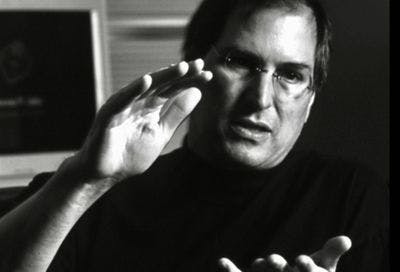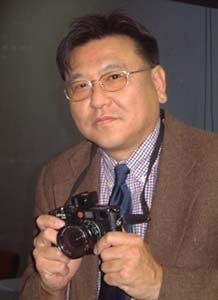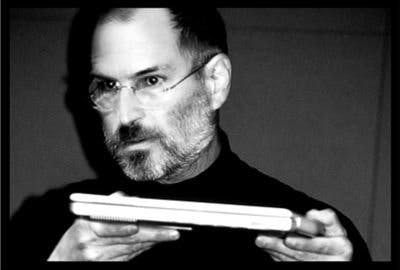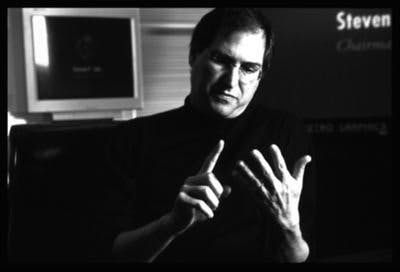
Distinguished Japanese photojournalist and media producer Naonori Kohira has designated Stanford Libraries as the digital repository of selections from his portfolio of Silicon Valley photographs. The archive comprises remarkable images of many Silicon Valley personalities including Stanford Libraries Advisory Council Chair Paul Saffo and several other Stanford alumni who have served in advisory capacities including membership on the Stanford Board of Trustees. The photographs also depict several whose papers and oral histories are housed at Stanford, such as Regis McKenna, Jef Raskin, John Warnock, Douglas Engelbart, John Sculley, Ted Nelson, and Andrew Grove.
Dr. Regan Murphy Kao, head of East Asia Library Special Collections and curator for Japanese collections, said, “Kohira possesses an eye for capturing his subjects in moments at once quotidian and timeless. In his hands, they are forever preserved as art. His photography will stun you and long remain etched in your consciousness. His is a truly unique perspective on the innovators of Silicon Valley.”

Kohira delivered the first tranche of the donation, 24 portraits of Steve Jobs, to coincide with observances of the tenth anniversary of Jobs’ death on 5 October 2011. The photos depict Jobs presenting the NeXT Computer at the San Francisco Symphony Hall in 1988, in a subsequent interview about the NeXT Computer at NeXT, Inc. in 1990, and presenting the Apple Computer opening speech at the Apple Store Ginza, Tokyo in 2003. Now installed in the Stanford Digital Repository, the photos are publicly viewable, although not downloadable, in Stanford Libraries’ online catalog, SearchWorks. “I am very happy that the photos will be around forever,” Kohira said. “Stanford University is the center of Silicon Valley, and I recognize its library as a place that remembers the evidence and records of the world's IT revolution.”
A graduate of the College of Art at Nihon University, Kohira lived and worked in Los Angeles from 1987-2009 and now resides in Tokyo. His international stature as a renowned photographer reflects his iconic images, shoots, and books on widely diverse topics including the Sex Pistols punk rock band, classic CD jackets, the mountainous crash site of Japan Airlines Flight 123, folk art and travels in the southeastern United States, the long-term aftermath of the atomic bombings of Hiroshima and Nagasaki, baseball player Hideo Nomo, and exclusive photographs for the Japanese magazine Focus.
Henry E. Lowood, the Harold C. Hohbach Curator for the History of Science & Technology Collections and curator for film and media collections, said, “Naonori Kohira’s photographs bring a distinct thoughtfulness and sensibility to the visual conversation among image collections in the Stanford Libraries that document contemporary technology and the evolution of Silicon Valley, such as the photographs of Doug Menuez, Carolyn Caddes, and Ira Nowinski.” Caddes is known for her 1986 book, Portraits of Success: Impressions of Silicon Valley Pioneers, and follow-up portraits of these pioneers and others on the rise in the mid-1990s for Nikkei, a Japanese business magazine. The Douglas Menuez Photography Collection at Stanford is the complete archive of the award-winning documentary photographer and includes more than 250,000 photographs recording the rise of Silicon Valley, some of which were used in his book, Fearless Genius: The Digital Revolution in Silicon Valley 1985-2000, and in exhibitions around the world. “Of course, I have Carolyn Caddes's photo books and I love Doug Menuez's sensibility,” Kohira said. “Ansel Adams and Elliott Erwitt were the major artistic influencers of my own work.” Adams, for example, famously photographed Russell and Sigurd Varian, fellow Sierra Club members and founders of one of the first high-tech companies in Silicon Valley.

“Silicon Valley looms large in the contemporary American imagination,” said Elizabeth Kessler, Lecturer and Coordinator for the American Studies Program at Stanford. “It is envisioned as the site and source of vibrant economic growth and technological innovation; as a disruptive force in social, economic, and political systems; as a surprisingly agile cultural behemoth that has reshaped human relationships and hierarchies of all sorts; as a brotopia built on the preferences and predilections of rich, geeky white guys; as a location with perpetually sunny skies and easy access to beaches and mountains.”
“In Silicon Valley, the fast-paced world of technology interfaces with academia, while the quirky influence of the counterculture lurks in the background,” Kessler concluded. Students in her Silicon Valley course examine cultural artifacts and study the region’s depiction in literature, film, television, and photography. “Portraits represent individuals, but also Silicon Valley as a place and a culture. I'm eager to incorporate Naonori Kohira's photographs into my course because they will offer students a transnational perspective on the people and history of the region," Kessler said.

Kohira and Kyoichi Katayama published recently about Jobs in Toyo Keizai Online(08/28/2021). Katayama stated, “As a result, all of the products that Jobs produced for the world had the characteristic of being his ‘work.’ ‘Work’ and ‘product’ are absolutely different... this can be called Jobs’ distinctive trait as a creator. What’s mysterious is that this characteristic carried through to his mass-produced industrial products. It’s extremely rare.” In the epilogue to his current project, a book entitled That day, Jobs…, Kohira recalled, “In 1993, when producing the photo collection of portraits of IT gurus entitled Silicon Road, I asked Jobs for his motto. He sent a fax saying, ‘object-oriented programming is the revolution of the 90s.’ I was fortunate enough to shoot photos of many legends of the IT revolution of that time, but the only one who could be called an artist was Steve Jobs.” Referring to Jobs’ influence on the music world, Kohira added, “This feel for fusing art and technology was precisely the first digital transformation.”
Michael A. Keller, the Ida M. Green University Librarian at Stanford, said, “The Naonori Kohira Photography Archive portrays luminary figures in Silicon Valley from the 1980s and beyond. We are most grateful for Mr. Kohira’s willingness to share his photos with us and with the academic world at large. In the fullness of time, scholars and students here at Stanford and elsewhere will be able to make non-commercial use of the photos in their research and teaching.”